Leah’s Tinu-om
Cabatuan, Iloilo
It was just this week that I first went to Cabatuan, Iloilo. I guess it is destiny that Sev and I became partners in doing our research proposal. I’m from Aklan and I haven’t been to some parts of Iloilo. Sev is from Cabatuan and that’s where the idea of researching for a traditional dish there, the Tinu-om na Manok, started.
It takes about an hour to get to Cabatuan. It has been a great experience travelling around our local towns in Iloilo. I got to see a lot of places, like the Coca Cola plant in Pavia, and then the town of Sta. Barbara. The long trip going there was quite exhausting but finally arriving there made it worth the time and effort. We got off at Cabatuan’s town plaza and walked to Leah’s Tinu-om near the town market. Lola Sabel was not there and so we went to her place. It’s funny realizing how we Pinoys are, no matter where we come from. You ask directions from someone (at Leah’s Tinu-om) and she doesn’t say the house number but rather she tells you the directions through landmarks or through someone famous’ house near your destination.

“It’s a family business!” said Lola Sabel. She’s referring to Leah’s Tinu-om, the only carinderia in Cabatuan known to serve the town’s remarkable dish. Lola Sabel says that she has been in the business for almost 30 years, both handling and cooking for the carinderia that was passed down to her by her parents, her father being the first to experiment in making the Tinu-om. She also told us that the Tinu-om was the reason all of her 6 children got to graduate from college. The restaurant was named “Leah’s Tinu-om” after one of her daughters.
Tinu-om is a native dish of the Cabatuanons is made up of native chicken seasoned with onions, tomatoes and lemon grass(tanglad) wrapped in banana leaves. It is served with broth that builds up inside its wrapping following a heavy steaming. Tinu-om in native language means “balot”, so Tinu-om na Manok means binalot na manok.
A serving of Tinu-om, which has 3-4 slices, costs Php50 at Leah’s Tinu-om. From a student’s point of view, yes, it is expensive but it’s worth the cost. Lola Sabel proudly says that every weekend many people from nearby towns visit her carinderia to taste her Tinu-om. Many carinderias in Cabatuan tried to make Tinu-om too, but failed in the process. One theory on why they failed would be because of the “timpla”. “Timpla” means taste proportionality of the mixed ingredients. This would mean that there are no specific measurements on how many teaspoons of vetsin there would be. The great thing about it is that it gives her confidence and it encourages her to continue making Tinu-om and to help promote the culture of Cabatuan.
When we asked Lola Sabel about her recipe in making her delicious Tinu-om, with no hesitation, she immediately replied.
The ingredients used are:
*Bumbay/Sibuyas (Onion)
*Kamatis (Tomato)
*Tanglad (Lemon Grass)
*Vetsin (MSG-monosodium glutamate)
*Asin (Salt)
*Tubig (water)
*Native Chicken – must be 7-14 months old.
*Banana Leaves
*Bamboo string or any string for tying up the tinu-om
*2 bowls for preparation
After enumerating the ingredients, she then told us how to do the Tinu-om na manok. There are 5 easy steps:
(1) In one bowl, place the chicken and season it with onion, tomato, vetsin and the salt and then add some water. The 7-14 month old chickens will have to boil for about 30 minutes for it to be ready for serving. Older chickens will take almost an hour. The picture on the side shows lola Sabel cutting up the chicken parts. One order of tinu-om would have 3-4 pieces.
(2) In another bowl prepare the banana leaves to be used for the wrap. Lola Sabel advices that you use Saba banana leaves rather than other kinds of banana leaf. It affects the flavor, aroma and outcome of the Tinu-om.
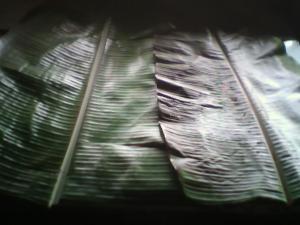
banana leaves
(3) Eventually, pour the marinated chicken into the bowl lined with banana leaf, gather the edges and tie it with a bamboo string or any piece of string. Make sure that it won’t leak.
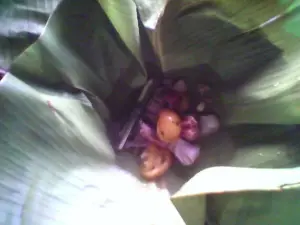
mixed ingredients
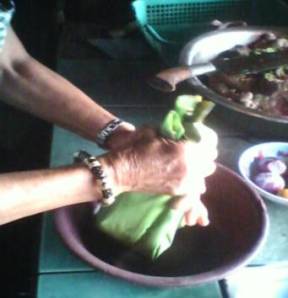
tying it up
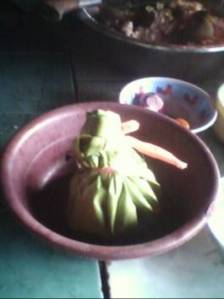
outcome
(4) After tying it up, place it in a casserole full of water and then place it on fire. You may steam it but Lola Sabel strongly suggests that you place it within the water casserole for a better result when it comes to taste. Then wait.
The continuous cooking and practice of making Tinu-om na Manok has lengthened its existence in Iloilo culture and tradition. The aroma of spices, chicken and banana leaves mixed together will always remain in the hearts of the Cabatuanons now and of the generations yet to come.
Just as Lola Sabel said, the recipe doesn’t have anything. It is not a secret. There is no secret ingredient. “Sa pagtimpla lang guid na ya, amuna siguro indi nila kami magaya sa pagluto sang Tinu-om.” (It’s in the proportioning of the ingredients to go side by side, maybe that’s why they can’t cook Tinu-om the way we do.)
You may find Lola Sabel at Leah’s Carinderia, Bermejo Street, Cabatuan, Iloilo. You can find Leah’s beside the street between Cabatuan Church and Cabatuan Wet Market. You can also contact her via text or call at 09287671244.
I assume that you have already read our article about the tinuom. In this section I will tell you about my views and insights on making this feature.
In my own perspective, having this paper work made me realize some things and question myself. Questions like what is Tinuom? What does it really mean to me as a Cabatuananon? Is it really the Tinuom that defines a Cabatuananon and its culture?
Every time I try to ask myself these questions I can find no right answers at all but thanks to this research work I was able to find some. Before our cultural festival Hirinugyaw was renamed to Tinuom in the year 2006 (it’s because of some conflict with other municipality’s festival name), I never knew that we have this tinuom that is said to be our delicacy here in Cabatuan. As told by the elders, those who have lived in the most number of years here in Cabatuan, Tinuom is indeed a mark of a Cabatuan. This is based on the stories they had inherited from the past generation just like what Lola Sabel said. Some of them says that it is but can’t find any explanation how it became such they just believe in it. My classmate’s grandparents told me that tinuom is indeed a mark of Cabatuan because we, Cabatuananons are the ones who had it first. Tinuom certainly defines what Cabatuan is and showcases the creativity of a Cabatuananon.
Yes, it is believed that Tinuom is a native of Cabatuan, but still some questions trigger me. If it is our delicacy then why is it that it’s not practiced in every household unlike other municipalities here in the Philippines having such delicacy like in the Miag ao, during fiesta every household has this KBL (kadios, baboy and langka) which is known to be their local dish served in their table.
I asked my friends and their parents if they do practice having this tinuom served in their table. Some of them told me that it’s because time passes by and things changes. There are some that carry out this tradition. It’s not lived out mostly in every household because several find it expensive to prepare tinuom especially when it comes to the cost of chicken. Some told me that it’s not easy to prepare, it takes time to cook it. Some that prefers to cook tinolang manok than to have it in tinuom because tinolang manok is faster to prepare than to tinuom. Some don’t even know how to prepare and cook tinuom. And there are some that knows how but are lazy enough to cook it, in my family’s case for example.
It’s sad to think that the past generation failed to pass this great tradition to the present generation. (It’s not that I’m blaming it all to them). Maybe it’s also because at one point in time we, Cabatuananon forgot that we have this legacy that we should preserve and pass it to the next future generation. That’s why I’m so thankful to Lola Sabel and her Leah Tinuom carinderia for not giving up and still having a business serving Tinuom. To her it may be just her simple way of earning a living, but for me she’s one of the people worthy to be recognized for preserving the culture of our town.
From the time we finished this paper, I realized what does tinuom means to me. Now I can proudly say that “Tinuom” is an evidence of how creative and special a Cabatuananon is. And this tinuom is a reminder to us Cabatuananons that we should preserve a tradition and a legacy that will be known in the whole world in the near future. Hahahahaha. And there’s no doubt about the tinuom being a definition of what a Cabatuananon is. No need to ask because it is what that defines us, believe me it is.
And now being able to feature “Tinuom” truly makes me feel proud as a Cabatuananon. Showcasing what a Cabatuananon has and can do gives me a sense of pride. Hope this entry or feature would further help promote tinuom and Cabatuan. And also would encourage other people to come and visit Cabatuan. Taste tinuom and experience Cabatuan.
About the authors:
Severo Caspe, Jr. and Christine Celeste Zaulda are both second year college students at the University of the Philippines in the Visayas. Sev is taking up BSBA Marketing while Bam is taking up BS Accountancy. You may contact us through email at nonoy_nami@yahoo.com and cceleste_z@yahoo.com

the researchers
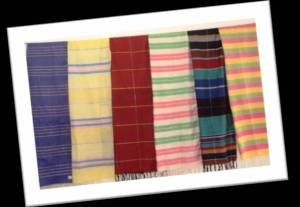

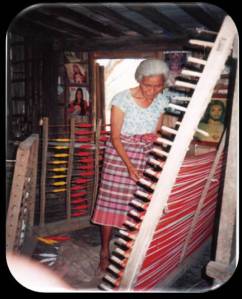

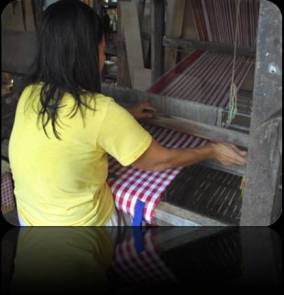

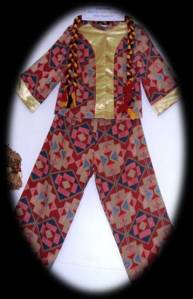




 As we stroll around the crowded city of Iloilo together with my partner Third, feeling the heat of the sun, we paused for a while because a man doing something caught my attention, not because his handsome but because I can see that he possessed a hand of an artist. He has unusual hand movements that I’ve never seen before. He was holding his magical pliers and his other hand holding a kind of stainless wire, so fine and slender, and after a few moments of giving his magical touch to that wire, he made it, a very beautiful masterpiece, a bracelet with beautiful designs on it.
As we stroll around the crowded city of Iloilo together with my partner Third, feeling the heat of the sun, we paused for a while because a man doing something caught my attention, not because his handsome but because I can see that he possessed a hand of an artist. He has unusual hand movements that I’ve never seen before. He was holding his magical pliers and his other hand holding a kind of stainless wire, so fine and slender, and after a few moments of giving his magical touch to that wire, he made it, a very beautiful masterpiece, a bracelet with beautiful designs on it.
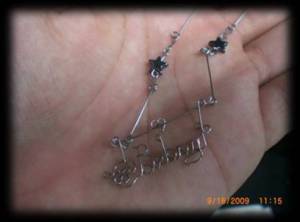
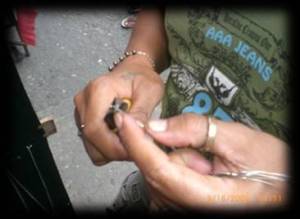
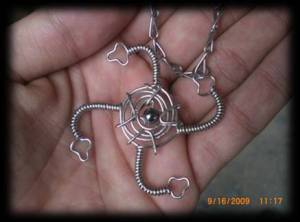

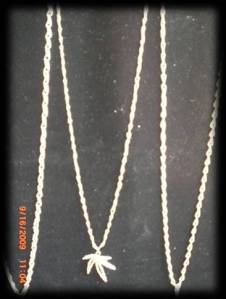

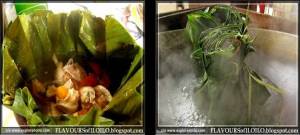

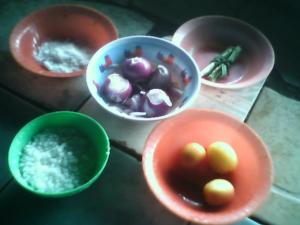
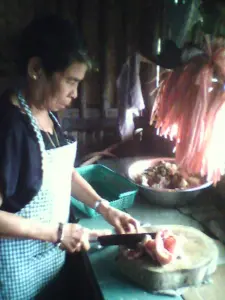





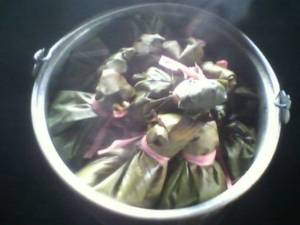


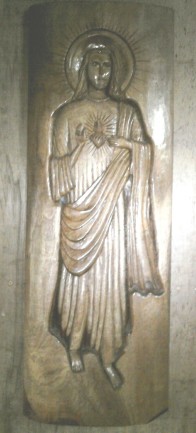 al education in the art of sculpting. We daresay, it was purely innate talent. You know, that unique inborn gift each of us is blessed with.
al education in the art of sculpting. We daresay, it was purely innate talent. You know, that unique inborn gift each of us is blessed with.
 an was his friend and so life must go on. Jerry still doesn’t have orders from customers and still a woodcutter.
an was his friend and so life must go on. Jerry still doesn’t have orders from customers and still a woodcutter. The Making of a Potter
The Making of a Potter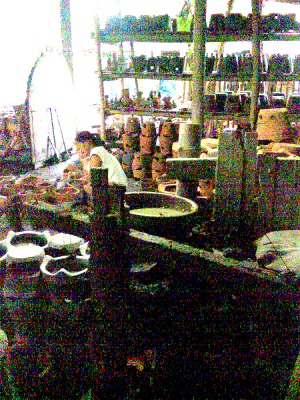
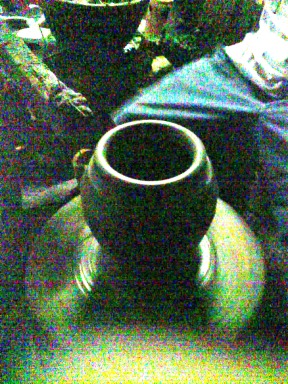 as unbelievable that the works of Nonoy were done by manual work alone.
as unbelievable that the works of Nonoy were done by manual work alone. Bead It All!
Bead It All!
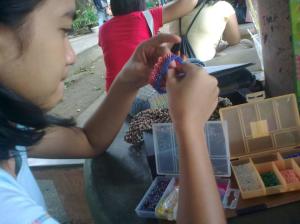
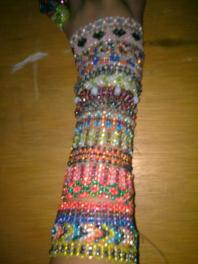
 make heart designs onbracelets
make heart designs onbracelets
 Have you seen Titanic? Remember the Jack sketching Rose moment? The way Jack draws those fine lines, which showcase the perfect shape of Rose’s body. How he sketched those delicate hands? What made it so classy and detailed? Aside from the craftsmanship of Jack, it’s the medium. Charcoal pencils allow the artist to create the heavy drama effect through the art of shadowing. It’s the same magic that applies to Rose portrait.
Have you seen Titanic? Remember the Jack sketching Rose moment? The way Jack draws those fine lines, which showcase the perfect shape of Rose’s body. How he sketched those delicate hands? What made it so classy and detailed? Aside from the craftsmanship of Jack, it’s the medium. Charcoal pencils allow the artist to create the heavy drama effect through the art of shadowing. It’s the same magic that applies to Rose portrait.
 And not only Manny Pacquiao could make it to the limelight. Everyone needs courage and strength to show the world what talents have been hiding inside your pockets. Knowing that behind those smiles as you revealed what you’ve got are criticisms that sometimes can really hurt us up to the bones. That’s what Nelson have to face in a world full of prestige, and talented ones that are used to the spotlight and already bagged some awards. Knowing very well ourselves that the weaknesses and strong sides could both help us improve our works, and Passion in what we are doing is the most important one; we find no reasons not to go on. Having these at heart Nelson could really make it to the top. We could not finish one project unless we are willing to give up some things just to have it.
And not only Manny Pacquiao could make it to the limelight. Everyone needs courage and strength to show the world what talents have been hiding inside your pockets. Knowing that behind those smiles as you revealed what you’ve got are criticisms that sometimes can really hurt us up to the bones. That’s what Nelson have to face in a world full of prestige, and talented ones that are used to the spotlight and already bagged some awards. Knowing very well ourselves that the weaknesses and strong sides could both help us improve our works, and Passion in what we are doing is the most important one; we find no reasons not to go on. Having these at heart Nelson could really make it to the top. We could not finish one project unless we are willing to give up some things just to have it. Anthony “Ton” Geduspan is a well known Ilonggo painter from Guimbal, Iloilo. His artforms, which are figurative cubism and classical realism, has captivated Ilonggo art lovers and other percepients.
Anthony “Ton” Geduspan is a well known Ilonggo painter from Guimbal, Iloilo. His artforms, which are figurative cubism and classical realism, has captivated Ilonggo art lovers and other percepients. The recognition he received as an artist are: first place in competitions like the provincial development cooperative official logo design contest, forest lake mural contest, red cross mural contest, second place during the bfar mural contest, and a provincial finalist for three years at the annual shell painting competition. His first solo exhibit was at Robinson’ place Iloilo.
The recognition he received as an artist are: first place in competitions like the provincial development cooperative official logo design contest, forest lake mural contest, red cross mural contest, second place during the bfar mural contest, and a provincial finalist for three years at the annual shell painting competition. His first solo exhibit was at Robinson’ place Iloilo.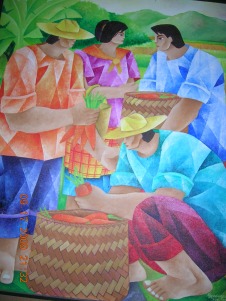 His realist artworks are often inspired by people and landscapes. His figurative cubism of intersecting geometric figures with his vibrant and dynamic color schemes give off the feeling of bliss to his percepients. His inspirations were the workds of famous painters like Manansala, Kiukok and Borlonga. His cubist oil on canvass works are mostly inspired by the bright side of nature. His paintings are rarely gloomy and focus on the happiness found on Philippine culture such as harvest, Filipino celebrations, rural scenes and common Filipino workers. Another thing is that he adds a “story book” or childish touch to his drawings. He paints persons, views and landscapes that can be appreciated not only by adults but people from all ages.
His realist artworks are often inspired by people and landscapes. His figurative cubism of intersecting geometric figures with his vibrant and dynamic color schemes give off the feeling of bliss to his percepients. His inspirations were the workds of famous painters like Manansala, Kiukok and Borlonga. His cubist oil on canvass works are mostly inspired by the bright side of nature. His paintings are rarely gloomy and focus on the happiness found on Philippine culture such as harvest, Filipino celebrations, rural scenes and common Filipino workers. Another thing is that he adds a “story book” or childish touch to his drawings. He paints persons, views and landscapes that can be appreciated not only by adults but people from all ages.
 Leonardo Da Vinci, Juan Luna, and Michelangelo are artists. And surely no one will question this!There’s no need to explain! But how does a person acquire the title “artist”? Is it by making great artworks that become very famous? If this is the criterion, then, I think we will neglect to give tribute to people who are qualified to be called artists. Take for instance the casket makers. Yes! You read it right! The casket makers. Sounds gothic? Not really. While Effegy and I were looking around the city, we got to meet two exceptional individuals: Elpidio Bernardo, 39, and Richard Ludas, 31, the casket makers of Porras Funeral Homes. Mister Elpidio is a native of Antique, Cabugao Sur, Sta. Barbara while Mister Richard is from Malusgod, Pototan, Iloilo. Co-workers and friends call them Panoy and Chard, respectively. Nong Panoy specializes in the carpentry whereas Nong Chard concentrates on the designing. They used to be servant boys in this funeral home when they were teenagers about 15 years ago. What year was that? Well, during their free time, they would observe the then casket makers in making and designing caskets.
Leonardo Da Vinci, Juan Luna, and Michelangelo are artists. And surely no one will question this!There’s no need to explain! But how does a person acquire the title “artist”? Is it by making great artworks that become very famous? If this is the criterion, then, I think we will neglect to give tribute to people who are qualified to be called artists. Take for instance the casket makers. Yes! You read it right! The casket makers. Sounds gothic? Not really. While Effegy and I were looking around the city, we got to meet two exceptional individuals: Elpidio Bernardo, 39, and Richard Ludas, 31, the casket makers of Porras Funeral Homes. Mister Elpidio is a native of Antique, Cabugao Sur, Sta. Barbara while Mister Richard is from Malusgod, Pototan, Iloilo. Co-workers and friends call them Panoy and Chard, respectively. Nong Panoy specializes in the carpentry whereas Nong Chard concentrates on the designing. They used to be servant boys in this funeral home when they were teenagers about 15 years ago. What year was that? Well, during their free time, they would observe the then casket makers in making and designing caskets.
 Now, visualize many, many caskets in front of you. These caskets exhibit a metallic finish. The exteriors are adorned by relief sculptures and interiors are well designed using henna cloth or silk cloth and laces, skirted with elegance and style. Constructing a casket is not an easy thing to do. Skills are important in this art form. Nong Panoy, for instance, specializes in the carpentry. Effegy asked him several questions about what’s and why’s and he answered her while hammering planks of wood. Imagine she hesitated for a bit if she should continue asking questions. She was afraid Nong Panoy might hammer his finger! Well, Nong Panoy is an expert and an artist so he won’t be distracted by her. In addition to that, he works very fast. Not just fast but he also completed his task with quality. Few minutes earlier, about 15 minutes, we just saw ready to be assembled pieces of wood and plywood being hammered to stick together. But now what we have in our front was an undoubtedly a casket. Still there’s something missing – the design.
Now, visualize many, many caskets in front of you. These caskets exhibit a metallic finish. The exteriors are adorned by relief sculptures and interiors are well designed using henna cloth or silk cloth and laces, skirted with elegance and style. Constructing a casket is not an easy thing to do. Skills are important in this art form. Nong Panoy, for instance, specializes in the carpentry. Effegy asked him several questions about what’s and why’s and he answered her while hammering planks of wood. Imagine she hesitated for a bit if she should continue asking questions. She was afraid Nong Panoy might hammer his finger! Well, Nong Panoy is an expert and an artist so he won’t be distracted by her. In addition to that, he works very fast. Not just fast but he also completed his task with quality. Few minutes earlier, about 15 minutes, we just saw ready to be assembled pieces of wood and plywood being hammered to stick together. But now what we have in our front was an undoubtedly a casket. Still there’s something missing – the design.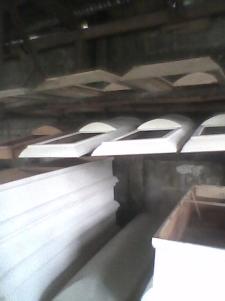
 Then using a spray gun, Nong Chard will paint the casket with automotive paint. Decorations were then added. Some of them are handles and figurines. Laces, henna cloth and silk cloth are attached for adornment purposes using tacks and small nails in the internal. What we saw was a casket ready for sale. When we examined the previous product and new one, we were really stunned because the casket looks very elegant and exhibit a metallic finish, even though we were there the making process, But then, it was what made it great. And what’s nice about Nong Panoy and Chard is that they don’t consider themselves artists. At the very beginning when we asked them for this interview, they were asking why we chose them. And Effegy answered that it was because their work is a unique profession. Their artwork is part of our artistic culture but not yet fully recognized. The title artist is not limited alone to those whose works are popular but also to those people who makes art! A Casket is an artwork. So, why don’t we call the casket makers artists? We believe they deserved the title! (^_^)
Then using a spray gun, Nong Chard will paint the casket with automotive paint. Decorations were then added. Some of them are handles and figurines. Laces, henna cloth and silk cloth are attached for adornment purposes using tacks and small nails in the internal. What we saw was a casket ready for sale. When we examined the previous product and new one, we were really stunned because the casket looks very elegant and exhibit a metallic finish, even though we were there the making process, But then, it was what made it great. And what’s nice about Nong Panoy and Chard is that they don’t consider themselves artists. At the very beginning when we asked them for this interview, they were asking why we chose them. And Effegy answered that it was because their work is a unique profession. Their artwork is part of our artistic culture but not yet fully recognized. The title artist is not limited alone to those whose works are popular but also to those people who makes art! A Casket is an artwork. So, why don’t we call the casket makers artists? We believe they deserved the title! (^_^)
